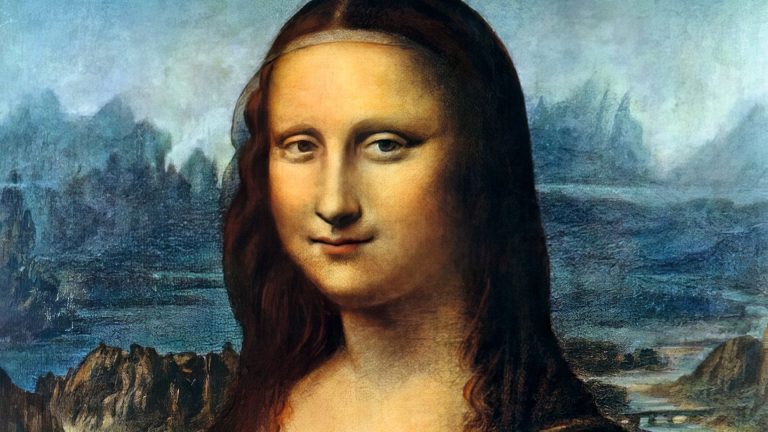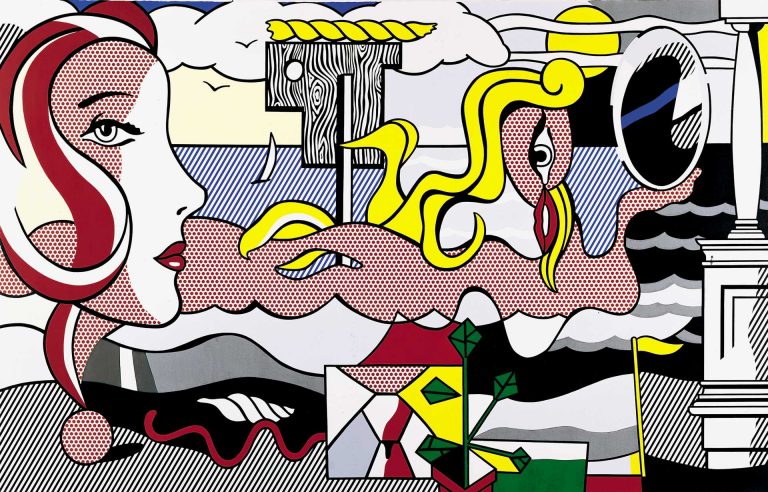One of the most famous paintings of the Florentine Renaissance hides many mysteries. In the midst of spring we learn the history of the creation of «Spring» and try to penetrate its riddles.
There are no exact documents telling about the circumstances of creation of «Spring», all that we know today, historians and art critics restore practically by detective way, comparing memoirs, accounts and other scarce remnants of information. One thing is certain: despite the lack of an author’s signature, La Primavera is indeed the work of the great Sandro Botticelli. But for whom did he create this gigantic two-metre canvas? It is almost certain that for his loyal clients, to the Lords of Florence of the Medici family. But it is not clear for whom or when, although there are strong hypotheses.
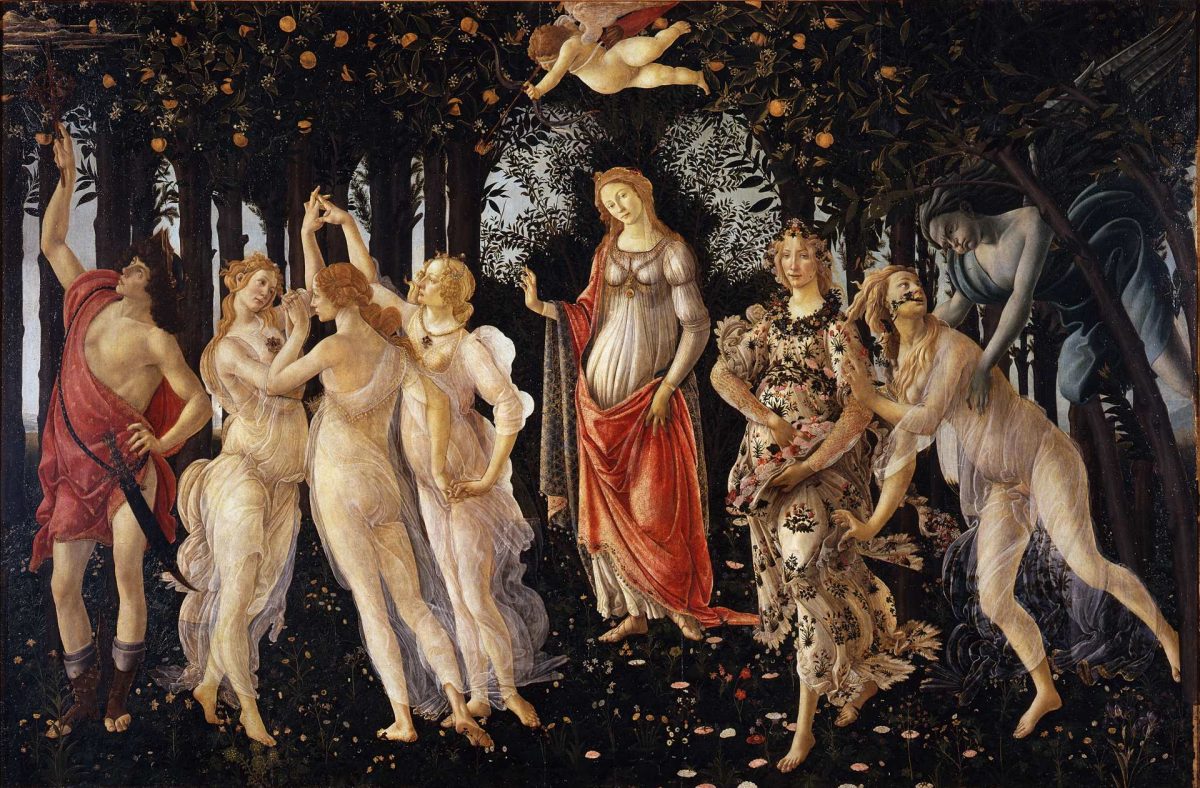
The version that now reigns in the theories of scientists (and, more importantly, for the dissemination of information – guides telling about the picture during walks through the halls of the Uffizi gallery) is based on an old document found in 1975. It turned out to be an inventory of the property of 1499, which stated that «Spring», as well as some other paintings in this year are kept in the city palace of Lorenzo di Pierfrancesco de Medici.
It was a young member of the dynasty, who was at that time supervised by his cousin, the head of the family and Florence – Lorenzo the Magnificent. The fact that «Spring» belonged to a very young person (born in 1463) made art critics «lower» the date of creation of the painting. Earlier, based on the style and episodes of Botticelli’s life, scholars assumed that the painting was painted in the 1470s and 1480s. In the biography of Lorenzo di Pierfrancesco, there was an important event that could have been marked by the creation of such a complex picture: in 1482 he married.
By the way, those who insisted on the early dating of the picture, as proof use the fact that the ladies in «Spring» resemble the beautiful Simonetta Vespucchi, in which Botticelli was unrequitedly in love. She died in 1476. However, firstly, in Botticelli’s paintings, many of the ladies look like Simonetta, even after her death, because artists have excellent visual memory. Secondly, in this case, the similarity proves quite the opposite: the bride in 1482 was a girl named Semiramide Appiano. We don’t know what she looked like, but it makes sense that she might have looked like her aunt. Coincidentally, she was Simonetta Vespucci.
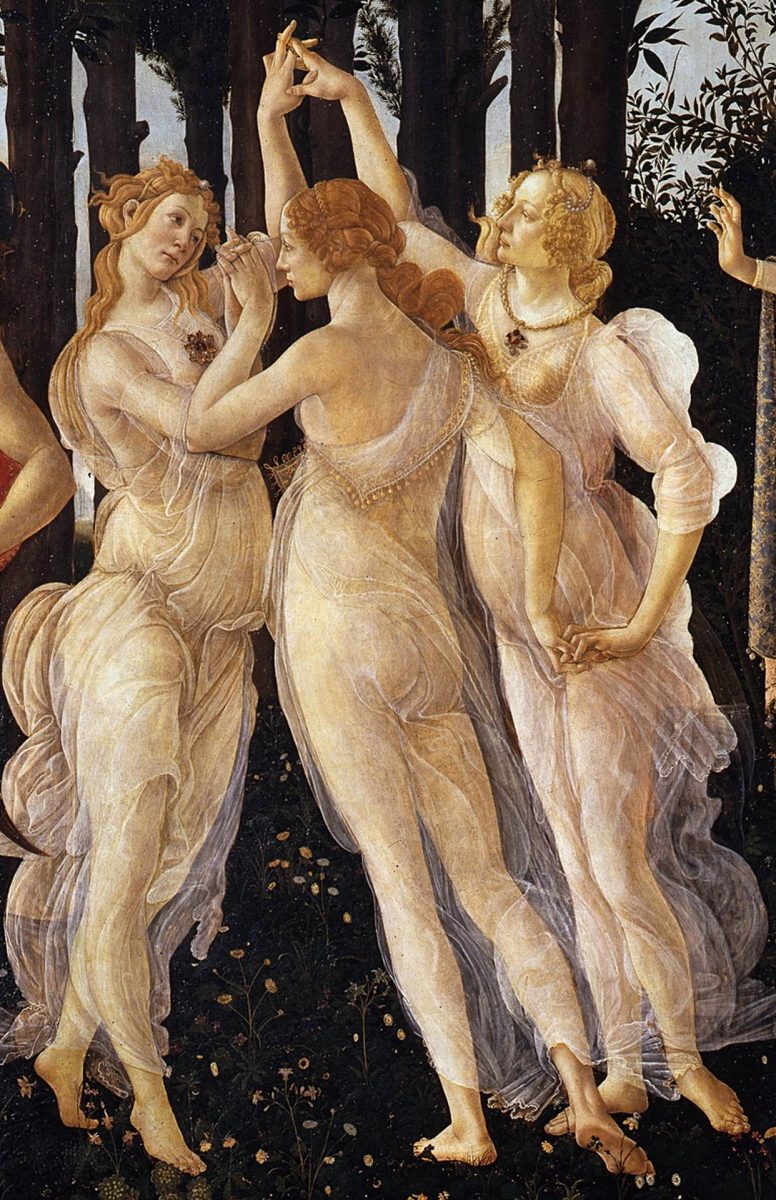
The theory that the painting was created as a valuable wedding gift from Fabulous is supported by a complex plot. During the Renaissance, rich and educated people adored ordering such intelligent riddle-paintings based on ancient mythology, Latin and Italian poetry. What is this picture?
Thank God the painting was described by the great Italian biographer Giorgio Vasari in 1550, when he saw it in one of the villas of the Medici. He mentioned that it is «Venus and Grazia, blooming, which means Spring». This made it much easier for subsequent generations to decipher, especially since the figures of the three dancing Grazius-the maids of Venus-were taken by the artist from a famous antique relief. Based on this mention, as well as on the lines from the poem of the ancient Roman poet Lucrezia «About the nature of things», the poem Ovidius «Fasta», as well as from «Rustic» of the Florentine poet of those years Policiano (perhaps he made up the complicated scheme for Botticelli)the characters are deciphered as follows.
The lady depicted in the geometric centre of the picture should be her main character, although she is lost in comparison with the colourful and exciting characters next to her. Most likely, it is Venus, Aphrodite, goddess not only of love, but also of flowering and gardens, fecundity and fertility. In addition, she “worked” as the goddess of lawful marriage, which is especially valuable in the picture dedicated to the wedding. The fact that in this case she is fully dressed, in contrast to the «Birth of Venus» Botticelli (next to which she hangs for centuries), emphasises the chastity of this hypostasis. Behind her are the thin branches of the myrtle bush, the old attribute of the goddess and the symbol of marriage.
Above her head is the baby Cupid (son of Venus), in his hands a bow and arrow. There is nothing to argue about – it is immediately clear by equipment.
Notice the tree canopy above the heroes’ heads – these are orange trees. The yellow citrus fruits look like golden balls, and these golden balls adorn the Medici family’s coat of arms, that is, the picture is immediately marked with heraldic symbols of the customer. This is one of the reasons why oranges suddenly began to bear fruit in the spring rather than at the right time; the other is because it depicts the mythical garden of Hesperid, where time goes by its own laws.
If you follow the arrow with your eyes , you can see that Cupid is targeting it at the centre of the three Graces, goddess of grace. And this is symbolic, as some scholars suggest: perhaps she, depicted in the profile, is the bride of Semiramis, niece of Simonetta.Thus, the painting tells the story of how the love for the groom arose in the heart of the newlyweds gods.
The fiancé of Lorenzo di Pierfrancesco de Medici is supposedly identified as the god Mercury (leftmost) with all his attributes – winged sandals, recognizable helmet, as well as the caduceus – a rod in a raised hand, with which he chases the cloud hidden in the upper left corner of the painting. Darkened by time, the cloud there is more like a piece of rock than a cloud, but the artist meant precisely the weather phenomenon, a symbol of winter, which is bound to disappear. Mercury, as the god (besides trade and theft) of the month of May, means the arrival of spring. He was also the god of doctors, that is, medics, and therefore the Medici dynasty also considered him its patron.
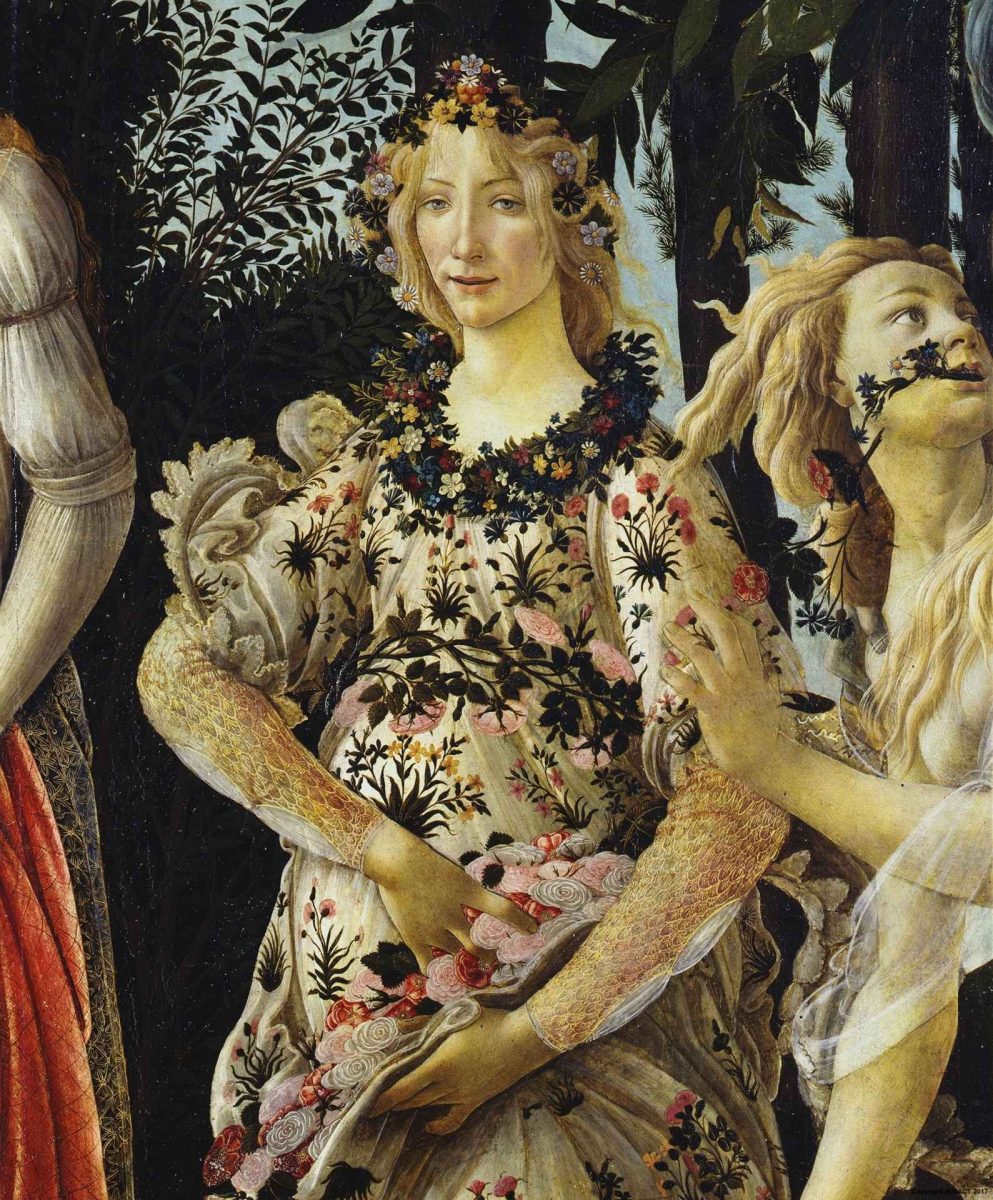
Now let’s go to the right part of the picture, where there is a female figure, which gave the name of the work – Spring, Primavera. Or maybe the goddess Flora. She is a pretty girl ( similar to Simonetta) with a wreath on her head and a garland of flowers around her neck. She has flowers in her skirt too, it seems that she’s going to throw them around. Her dress is embroidered with flowers, while the flowers bloom under her feet – the goddess appears before us in all her power. It is her appearance that the picture is devoted to.
Finally, next to her is the figure of a running half-naked girl who is trying to catch a blue flying creature. This is the saddest of the scenes in the picture. The blue creature is a flying deity of the West Wind whose name Zephyr has become a household name. Notice his facial expression: The Zephyr has inflated his cheeks, as if about to blow. This is a traditional depiction of wind in Western art. The ancient myth depicted here by Botticelli tells how the god Zephyr, seeing a beautiful girl named Chloride, attacked her from heaven and kidnapped her. Chloride, whose name translates as «green», transformed into the goddess of nature Flora after this attack and forced marriage from horror and shame transformed into the goddess of nature Flora. The moment of transformation we observe: from the mouth of the girl running flowers fall. She’s reborn as the happy Flora Primavera that Botticelli painted right next to her. So basically, for Chloride, it was a happy ending. But it’s too complicated, and it’s hard for us modern people to understand why he put it on a wedding gift.
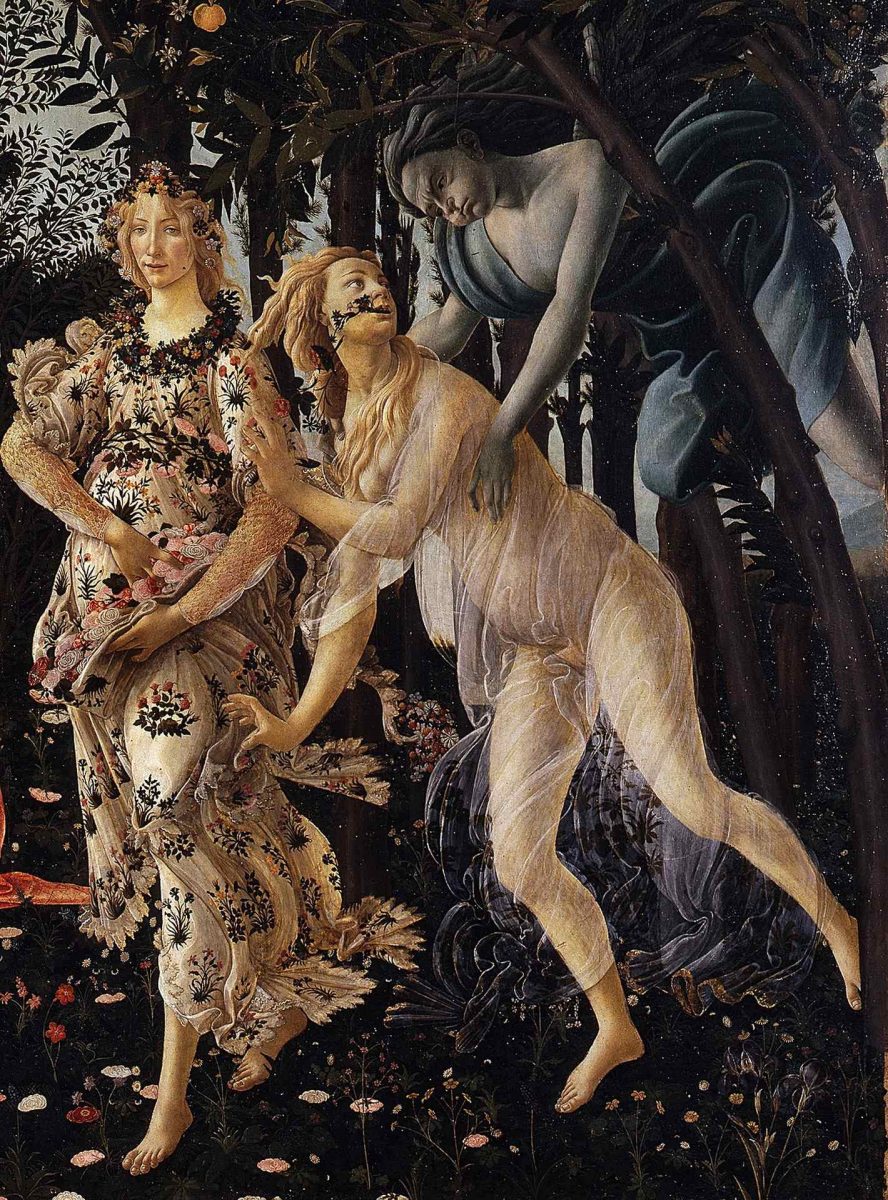
This is the simplest and most common of the current interpretations of Botticelli’s «Spring». However, it is not the only one. Other art historians have versions about Love of the Flesh and Love of the Earth, an allegory of the city of Florence (which is also «blooming»), the embodiment of Mind and other neoplatonic concepts, Generosity, Sweetness and so on.
But the main thing that gives charm to «Spring» is the variety of plants depicted here. Guido Mocci, the director of the Florentine Botanical Garden, once dealt with this question. And as a result, he counted in the picture more than 500 species of flowers belonging to 170 groups. Botticelli supposedly did not draw them directly from nature, but rather to have been covered by herbarium manuscripts, various herbalists, drawing page by page. From here there is such a dispersion (and different timing of flowering).
Photo: eclecticlight.co, wikimedia.org, uffizi
